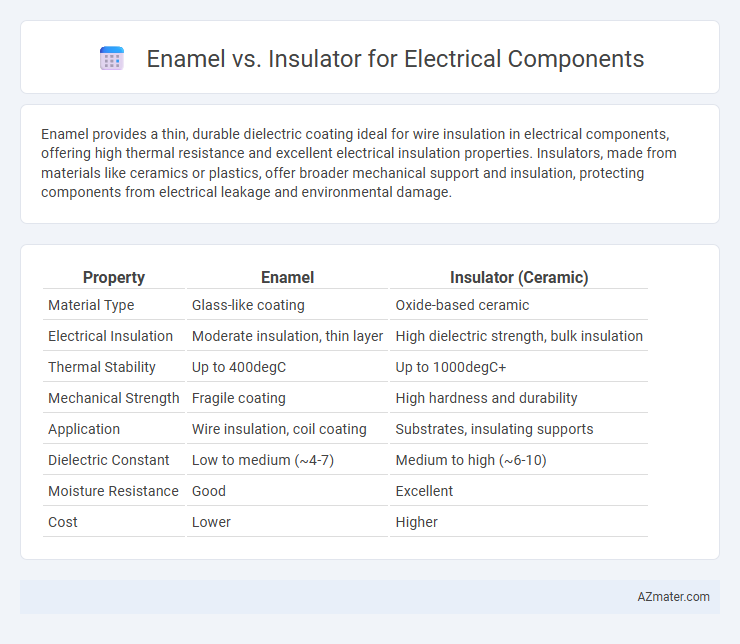Enamel provides a thin, durable dielectric coating ideal for wire insulation in electrical components, offering high thermal resistance and excellent electrical insulation properties. Insulators, made from materials like ceramics or plastics, offer broader mechanical support and insulation, protecting components from electrical leakage and environmental damage.
Table of Comparison
| Property | Enamel | Insulator (Ceramic) |
|---|---|---|
| Material Type | Glass-like coating | Oxide-based ceramic |
| Electrical Insulation | Moderate insulation, thin layer | High dielectric strength, bulk insulation |
| Thermal Stability | Up to 400degC | Up to 1000degC+ |
| Mechanical Strength | Fragile coating | High hardness and durability |
| Application | Wire insulation, coil coating | Substrates, insulating supports |
| Dielectric Constant | Low to medium (~4-7) | Medium to high (~6-10) |
| Moisture Resistance | Good | Excellent |
| Cost | Lower | Higher |
Introduction to Enamel and Insulator in Electrical Components
Enamel serves as a thin, protective coating with excellent dielectric properties used to insulate wire windings in electrical components, preventing short circuits and enhancing durability. Insulators, such as ceramic, glass, or plastic materials, provide high resistance to electric current, isolating conductive parts to ensure safe and efficient operation of electrical devices. Both enamel and traditional insulators play critical roles in maintaining electrical integrity and performance in motors, transformers, and other circuitry.
Material Composition: Enamel vs Insulator
Enamel coatings in electrical components typically consist of polymer resins such as polyurethane, polyester, or epoxy, providing excellent insulation through a thin, durable film directly applied to wire surfaces. Insulators, on the other hand, are generally made from bulk materials like ceramics, glass, or specialized plastics such as polyethylene and PVC, offering high dielectric strength and mechanical support in electrical systems. The enamel's material composition allows for compact, flexible insulation in tightly wound coils, whereas insulators ensure robust protection and separation in larger, high-voltage equipment.
Electrical Properties and Performance
Enamel coatings serve as effective electrical insulators with high dielectric strength, providing excellent resistance to electrical breakdown and thermal stability in winding wires and electrical components. Insulator materials, such as ceramics or polymers, offer superior insulation resistance and mechanical durability, minimizing leakage currents and enhancing the longevity of electrical systems. The choice between enamel and traditional insulators depends on application-specific requirements like voltage ratings, thermal endurance, and mechanical flexibility.
Thermal Resistance Comparisons
Enamel coatings provide moderate thermal resistance suitable for protecting electrical components while allowing efficient heat dissipation. Insulators typically exhibit higher thermal resistance, effectively preventing heat transfer and protecting sensitive components from thermal damage. Choosing between enamel and insulator materials depends on the specific thermal management requirements and operating temperatures of the electrical device.
Mechanical Strength and Durability
Enamel coatings on electrical components provide superior mechanical strength due to their ability to resist abrasion, impact, and environmental stresses, enhancing durability in high-vibration and high-temperature conditions. Insulators, typically made from ceramics or polymers, offer excellent electrical isolation but may lack the same mechanical toughness, often becoming brittle or degrading under mechanical strain. Choosing enamel over traditional insulators improves overall component longevity by combining robust protection with effective electrical insulation.
Applications in Electrical Engineering
Enamel coatings serve as insulating layers on electrical wire coils and motors, providing thin, durable insulation that preserves conductivity while preventing short circuits. Insulators, such as ceramic, glass, or polymer materials, are used in high-voltage applications to separate conductive parts and prevent electrical leakage or breakdown. In electrical engineering, enamel is preferred for compact winding insulation, whereas traditional insulators are critical for structural support and safety in power transmission and distribution systems.
Advantages of Using Enamel-Coated Wires
Enamel-coated wires offer superior insulation with a thin, uniform layer that enables high-density winding in transformers and motors, enhancing electrical efficiency and reducing size. The enamel coating provides excellent thermal resistance, maintaining performance under elevated temperatures and preventing short circuits. This insulation method also improves durability against mechanical stress and chemical corrosion, ensuring longer lifespan and reliability in electrical components.
Benefits and Limitations of Traditional Insulators
Traditional insulators such as ceramic, glass, and plastic offer excellent electrical resistance and thermal stability, making them reliable for preventing current leakage and short circuits in electrical components. However, their brittleness, limited mechanical strength, and susceptibility to environmental degradation like moisture absorption pose challenges for long-term durability and performance. Unlike enamel coatings that provide flexible, thin dielectric layers with good adhesion and heat resistance, traditional insulators often lack versatility in complex or compact electrical designs.
Cost-Effectiveness and Manufacturing Considerations
Enamel coating on electrical components offers a cost-effective solution due to its minimal material usage and compatibility with automated manufacturing processes, resulting in reduced production time and expenses. Insulators such as plastic or ceramic often incur higher costs from raw materials and complex molding or firing steps, which can increase overall manufacturing expenditure. Selecting enamel versus traditional insulators depends heavily on the balance between desired insulation performance, thermal resistance, and scalable production efficiencies within the manufacturing environment.
Choosing Between Enamel and Insulator: Key Decision Factors
Choosing between enamel and insulator for electrical components depends largely on the application's voltage rating, thermal stability, and mechanical durability requirements. Enamel coatings offer excellent insulation with thin layers ideal for compact designs and high-frequency applications, while traditional insulators provide robust protection against physical damage and higher voltage tolerances. Consider factors like operating temperature, chemical exposure, and flexibility when selecting the appropriate material to ensure optimal performance and longevity.

Infographic: Enamel vs Insulator for Electrical Component
 azmater.com
azmater.com